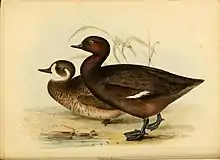Southern pochard
The southern pochard (Netta erythrophthalma) is a species of duck, and a member of the genus Netta. There are two subspecies, the South American (southern) pochard N. e. erythrophthalma (Wied-Neuwied, 1833) and the African (southern) pochard N. e. brunnea (Eyton, 1838).
| Southern pochard | |
|---|---|
_RWD1.jpg.webp) | |
| Male southern pochard | |
 | |
| Female southern pochard | |
| Scientific classification | |
| Kingdom: | Animalia |
| Phylum: | Chordata |
| Class: | Aves |
| Order: | Anseriformes |
| Family: | Anatidae |
| Genus: | Netta |
| Species: | N. erythrophthalma |
| Binomial name | |
| Netta erythrophthalma (Wied, 1833) | |
| Synonyms | |
|
Anas erythrophthalma Wied-Neuwied, 1833 | |
The South American pochard has a fragmented range and is found from Colombia, Venezuela, Brazil, Ecuador, Peru, Bolivia and Argentina to Chile. Here it occurs in a wide variety of shallow fresh waters with submerged vegetation, from the lowlands up to 3,700 metres.
The African pochard occurs from the Cape to the Ethiopian highlands on water bodies with or without emergent vegetation. They are suspected to have been strong migrants in the past but the construction of numerous farm dams seems to allow them a more sedentary lifestyle. They reach highest concentrations in Africa's central plateaus and in the south-western winter rainfall region.
Taxonomy
Two syntype specimens of Nyroca brunnea Eyton (Monogr. Anat., 1838, p.161., pl.23.), the African Southern Pochard, are held in the collections of National Museums Liverpool at World Museum, with accession numbers D832 (male adult) and D832a (female adult). The specimens were collected in South Africa and came to the Liverpool national collection via Thomas Campbell Eyton’s collection and the 13th Earl of Derby’s collection which was bequeathed to the city of Liverpool.

Habits
Southern pochards are sociable and gregarious. They have been seen in groups of up to 5,000.
Mating and nesting
The birds are solitary nesters, building nests out of leaves and stems on the banks of a river surrounded by vegetation.[2] The female southern pochard lays a clutch consisting of six to fifteen eggs. The female incubates the eggs for 20 to 28 days.[2] Once the eggs hatch, the mother leads them immediately to water.
References
- BirdLife International (2012). "Netta erythrophthalma". IUCN Red List of Threatened Species. 2012. Retrieved 26 November 2013.CS1 maint: ref=harv (link)
- "Netta erythrophthalma". biodiversityexplorer.org. Retrieved 23 October 2017.
- "Pochard". www.britannica.com. Encyclopedia Britannica. Retrieved 23 October 2017.
- "Southern pochards". beautyofbirds.com. Retrieved 24 October 2017.
- Cisneros-Heredia, Diego F. "Información Sobre la Distribución de Algunas Especies de Aves de Ecuador" (PDF). Boletín SAO (in Spanish). XVI (1): 7.
- Maclean, G.L.; Harrison, J.A. "Southern Pochard". The atlas of southern African birds. Volume 1: Non-passerines.
External links
| Wikimedia Commons has media related to Netta erythrophthalma. |
| Wikispecies has information related to Netta erythrophthalma. |
